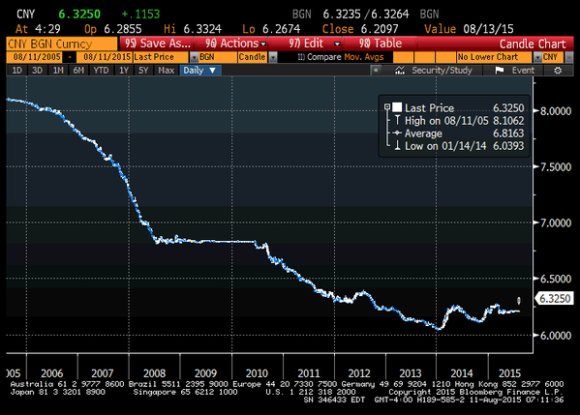This one comes from AMA section – what is the China devaluation and why do people care so much?
So, China devalued the Yuan/Renminbi overnight. I’m not sure why there’s still so much usage of Renminbi (which is the equivalent of saying “the People’s Money”), but I am pretty sure that only the cool kids say that in China whereas Yuan is more like saying “dollar”. Since we’re definitely not the cool kids we’re going to stick with Yuan.
What Did China Just Do?
China maintains a “soft” peg for their currency. This means that they don’t let the currency fully float, but rather let it float within a band. This is called the “daily fix”. China establishes a target price for the currency and allows it to float as much as 2% from the target price. Today, they shifted that target price 1.86% lower. The reason they run this soft peg is because they’re probably worried that the Yuan would fall too fast which would make Chinese exporters uncompetitive. As they boost domestic demand they’re trying to achieve this at a moderate rate so as to avoid harming the domestic economy excessively.
Why Did China Do This?
There’s considerable debate about this. The Chinese want us all to think that they’re letting the currency float a little more liberally to reflect “market” prices. There’s been some discussion about the need to liberalize the CNY market as the IMF will be voting on the inclusion of the CNY in its reserve currency basket later this year. I don’t really buy this argument.
The more likely cause of this was China’s very weak export report over the weekend. They reported an 8.3% decline in exports which was well below expectations. The fact that a currency shift occurred on the heels of this weak report is all too coincidental. It’s a near certainty that Chinese officials felt the need to intervene to help boost domestic exporters.
How Much Did They Devalue The CNY?
The Yuan was devalued by 1.86% overnight. The chart below (via Mark Dow) puts the move in the proper perspective. As you can see, this isn’t a huge game changer in the grand scheme of things. But the very fact that it is being done could be a sign of broader problems in China.
What Will be the Fallout Here?
- The obvious signal is that China’s economy is weak. I’ve mentioned in the past that we’re moving into a world where, when China sneezes, the world catches a cold. This is just an inevitable outcome from China’s economic growth and global reach. China is a massive exporter of goods as well as a huge consumer of commodities. If their economy is much weaker than many expect then it will be difficult to contain yourself from its impact. This isn’t Greece after all. China is fast becoming one of the world’s largest and most important economies.
- The Fed is likely to view this as further reason to be cautious. We’ve heard numerous reports about the stronger dollar hurting US competitiveness during this earning’s season. This is not something the Fed wants to exacerbate. I think this increases the odds of delaying the September rate hike. The Fed seems to be on a totally different page from the rest of the world.
- The big winners here are obviously Chinese exporters and the losers are China’s big export competitors. Without a response from their own Central Banks this means that export competitors are that much weaker.
- The more interesting result is the sustained effect here. Is the CNY now going to be viewed as a one way devaluation trade? China claims this was a “one off” event, but the markets won’t see it that way. More importantly, how will other Central Banks respond? The currency wars have been in effect for years as everyone tries to export their way to growth, but I am not sure there are going to be any definitive winners there.
Mr. Roche is the Founder and Chief Investment Officer of Discipline Funds.Discipline Funds is a low fee financial advisory firm with a focus on helping people be more disciplined with their finances.
He is also the author of Pragmatic Capitalism: What Every Investor Needs to Understand About Money and Finance, Understanding the Modern Monetary System and Understanding Modern Portfolio Construction.

